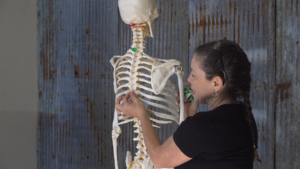Introduction
Our sincere thanks to Dr. Justine Bernard for creating this enlightening article. Read on as Master Trainer Justine Bernard unveils the fundamental role of bones as navigational tools within the Gyrotonic and Gyrokinesis Methods. Offering a glimpse into her recent Master Class: Using Bones as a Guide to Observe Movement, she delves into how bony landmarks serve as invaluable guides for both Trainers and clients alike, facilitating a deeper understanding of movement patterns and asymmetries. Through palpitation and observation of key landmarks, Dr. Bernard demonstrates how trainers can enhance their client’s awareness and tailor exercises to optimize movement efficiency.
__________________________________________________
Written by Dr. Justine Bernard

As Gyrotonic trainers we are movement professionals; we are trained to watch and guide bodies through space in a variety of patterns. One ideal tool to observe and guide movement is bones, also known as bony landmarks.
Bones are simple to observe and palpate making them an ideal guide, like a GPS or compass for the body. There are bony prominences that allow us to orient our eyes and hands to observe asymmetries from right to left or rotations in moving bodies. For example, the ilium bones (hip bones) may be level, elevated or rotated. Other landmarks we can easily feel are the clavicle (collar bone), scapula (shoulder blade), patella (knee caps). We can also observe how the muscles are moving these bones. For example, are the muscles more active around the right or left scapula? In another example, observing arch and curl on the handle we can see the spinous processes of the vertebrae to bring awareness to the curves and rotations of the spine again allowing us to observe symmetries or asymmetries. Then use these findings to increase the client’s awareness of how they are moving, modify the exercise, and choose which exercise or which hand holds to use next.

Not only can we use bones to guide clients, but we can use them for developing our own or our clients’ self awareness. We frequently come in contact with our bones often throughout Gyrotonic and Gyrokinesis classes. When we do awakening-the-senses we feel the skull bones and where they connect to cartilage at the ears and nose, we massage the bones and joints of the hands and feet and we tap down the femur bone “knocking the muscle off the bone.” We feel our pelvic bones when we do our seated-figure-8s around the sit bones aka ischial tuberosities of the pelvis. We can use these sensations to self correct, or guide our own practice increasing our internal intrinsic body awareness. We often sense and feel our bones in our own practice and as trainers we can encourage this awareness and exploration of bones in our clients too.
Bones are an integral part of all our systems including endocrine, immune, sympathetic nervous, and the vascular systems as well as an incredible landmark to use when teaching, exploring and observing movement. I hope I have inspired your curiosity to observe and sense the bones while teaching and practicing the Gyrotonic and Gyrokinesis methods.
Licensed Gyrotonic Trainers who are interested in diving deeper can check out my Gyrotonic Master Class, Bony Landmarks: Using Bones as a Guide to Observe Movement. See a preview below.
If you would like to learn more about Dr. Justine Bernard and her offerings, please visit Elements Center or contact Elements Center directly. Elements Center also has a non-profit branch with a mission to diversify the fields of Gyrotonic and Gyrokinesis. To learn more, visit Beyond Elements.
Interested in taking a course with Dr. Justine Bernard? Find her Teacher Training Course schedule here.
_________________________________________________
Want to read more? Take a look at other articles featuring Dr. Justine Bernard:
Physical Therapy with the GYROTONIC® Method
Specialized Course Highlight: GYROTONIC® Applications for Osteoporosis
Tips for Trainers, By Trainers: Creating a Successful Studio
To find Gyrotonic and Gyrokinesis classes near you, visit our Studio Finder tool.
To learn more about how to become a Gyrotonic or Gyrokinesis Trainer, visit our Teacher Education page.
GYROTONIC®, GYROTONIC® & Logo, GYROTONIC EXPANSION SYSTEM®, GYROKINESIS® and GYROTONER® are registered trademarks of Gyrotonic Sales Corp and are used with their permission.

